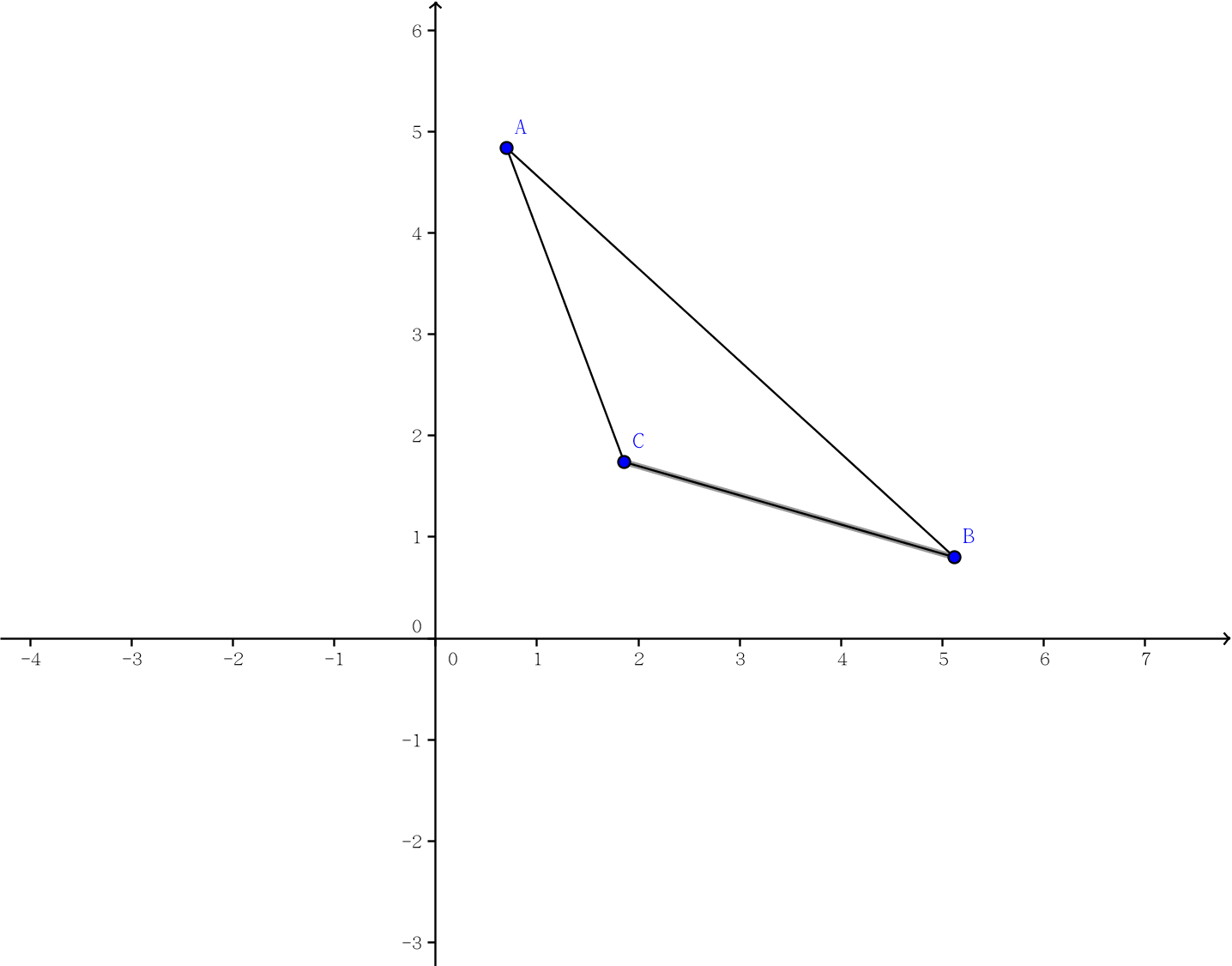题面
题解
将(sum_i c_i)和(sum_i t_i)分别看做分别看做(x)和(y),投射到平面直角坐标系中,于是就是找(xy)最小的点
于是可以先找出(x)最小的点(mathrm{A})和(y)最小的点(mathrm{B}),然后找到在(mathrm{AB})左下方的最远的点(mathrm{C}),如图所示:

即(overrightarrow{mathrm{AB}} imes overrightarrow{mathrm{AC}})最小(因为(overrightarrow{mathrm{AB}} imes overrightarrow{mathrm{AC}} leq 0))
[egin{aligned}
ecause overrightarrow{mathrm{AB}} imes overrightarrow{mathrm{AC}} &= (x_{mathrm{B}} - x_{mathrm{A}})(y_{mathrm{C}} - y_{mathrm{A}}) - (y_{mathrm{B}} - y_{mathrm{A}})(x_mathrm{C} - x_mathrm{A}) \
&= (x_mathrm B - x_mathrm A) imes y_mathrm C + (y_mathrm A - y_mathrm B) imes x_mathrm C + y_mathrm B x_mathrm A - x_mathrm B y_mathrm A
end{aligned}
]
然后发现只要((x_mathrm B - x_mathrm A) imes y_mathrm C + (y_mathrm A - y_mathrm B) imes x_mathrm C)最小即可。
将每条边的权值改为(mathrm{g}[i][j] = (y_mathrm A - y_mathrm B) imes c[i][j] + (x_mathrm B - x_mathrm A) imes t[i][j]),跑一遍最小生成树就可以得出答案了。
找到(mathrm C)之后用叉积判断一下(mathrm C)是不是在(mathrm{AB})的下方,如果是的话,就递归处理(mathrm{AC, CB})
复杂度?O(能过)
因为(mathrm{A, B, C})肯定在凸包上,又(n)个点的凸包期望点数为(sqrt{ln n}),
于是复杂度为(mathrm{O}(sqrt{ln n!} imes n^2))或者(mathrm{O}(sqrt{ln n!} imes mlog m))
代码
#include<cstdio>
#include<cctype>
#include<algorithm>
#define RG register
const int N(210), INF(1e9);
struct vector { int x, y; };
vector ans = (vector) {INF, INF};
inline vector operator - (const vector &lhs, const vector &rhs)
{ return (vector) {lhs.x - rhs.x, lhs.y - rhs.y}; }
inline int operator * (const vector &lhs, const vector &rhs)
{ return lhs.x * rhs.y - lhs.y * rhs.x; }
int g[N][N], f[N][N], dis[N], c[N][N], t[N][N], cdis[N], tdis[N], vis[N], n, m;
vector prim(int valx, int valy)
{
for(RG int i = 1; i <= n; i++)
for(RG int j = 1; j <= n; j++)
if(f[i][j]) g[i][j] = valx * c[i][j] + valy * t[i][j];
std::fill(dis + 1, dis + n + 1, INF);
std::fill(vis + 1, vis + n + 1, 0);
dis[1] = cdis[1] = tdis[1] = 0;
vector res = (vector) {0, 0};
for(RG int i = 1; i <= n; i++)
{
int _min = INF, x = -1;
for(RG int j = 1; j <= n; j++)
if(_min > dis[j] && (!vis[j])) _min = dis[j], x = j;
if(_min == INF) break; vis[x] = 1;
res.x += cdis[x], res.y += tdis[x];
for(RG int j = 1; j <= n; j++) if(f[x][j])
if(dis[j] > g[x][j]) dis[j] = g[x][j],
cdis[j] = c[x][j], tdis[j] = t[x][j];
}
long long sum = 1ll * res.x * res.y, _min = 1ll * ans.x * ans.y;
if(sum < _min || (sum == _min && res.x < ans.x)) ans = res;
return res;
}
void solve(const vector &A, const vector &B)
{
vector C = prim(A.y - B.y, B.x - A.x);
if((B - A) * (C - A) >= 0) return;
solve(A, C); solve(C, B);
}
int main()
{
scanf("%d%d", &n, &m);
for(RG int i = 1, x, y, _c, _t; i <= m; i++)
scanf("%d%d%d%d", &x, &y, &_c, &_t), ++x, ++y,
c[x][y] = c[y][x] = _c, t[x][y] = t[y][x] = _t,
f[x][y] = f[y][x] = 1;
vector A = prim(1, 0), B = prim(0, 1);
solve(A, B); printf("%d %d
", ans.x, ans.y);
return 0;
}